Introducing the Toshiba Satellite L645D-S4106
While the drought of Sandy Bridge notebook hardware is thankfully approaching its sweet, merciful end, there are still a healthy amount of AMD-based notebooks on the market at good prices awaiting happy homes. Toshiba was kind enough to send us their L645D, a 14" notebook sporting a mobile Phenom II dual-core processor running at a speedy 3GHz, Radeon HD 4250 integrated graphics, and a Blu-ray drive: all yours for a potentially exciting value proposition of just $619. Is it worth it?

The Toshiba L645D would seem bog standard for a budget AMD notebook if not for two things: the Phenom II N660 powering it is the fastest "non-extreme" dual-core mobile processor AMD offers, and Toshiba packs it into a 14" chassis instead of the 15.6" ones we've become accustomed to. Top that off with a Blu-ray drive and you have the makings of a strong multimedia contender at a reasonable price. So let's see how Toshiba specs it.
| Toshiba L645D-S4106 Specifications | |
| Processor | AMD Phenom II N660 (2x3GHz, 45nm, 2MB L2, 35W) |
| Chipset | AMD RS880M Northbridge + AMD SB800 Southbridge |
| Memory | 2x2GB DDR3-1066 (Max 2x4GB) |
| Graphics | ATI Radeon HD 4250 IGP (40 stream processors, 500MHZ core clock) |
| Display | 14" LED Glossy 16:9 1366x768 (AU Optronics B140XW01 V6 Panel) |
| Hard Drive(s) | Toshiba 640GB 5400RPM SATA 3Gbps Hard Disk |
| Optical Drive | BD-ROM/DVD+-RW Combo Drive w/ Labelflash |
| Networking | Atheros AR8152 10/100 Ethernet Realtek RTL8188CE 802.11b/g/n |
| Audio | Conexant Cx20585 HD Audio Stereo speakers Headphone and microphone jacks |
| Battery | 6-Cell, 10.8V, 48Wh battery |
| Front Side | Indicator lights SD/MS/MMC reader |
| Left Side | Kensington lock Exhaust vent Ethernet jack HDMI Combo eSATA/USB 2.0 USB 2.0 Microphone jack Headphone jack |
| Right Side | Optical drive USB 2.0 VGA AC adaptor jack |
| Back Side | - |
| Operating System | Windows 7 Home Premium 64-bit |
| Dimensions | 13.3" x 9.13" x 1.34"-1.50" (WxDxH) |
| Weight | 4.98 lbs |
| Extras | Webcam Flash reader (MMC, SD/Mini SD, MS/Duo/Pro/Pro Duo) Blu-ray drive |
| Warranty | 1-year limited warranty |
| Pricing | MSRP at $699 Available online at $619 |
Right off the bat, there's the dual-core AMD Phenom II N660 processor running at 3GHz. AMD now has an ungainlythree different mainstream mobile processor lines with the Athlon, Turion, and Phenoms basically in order of "good, better, best" and sporting borderline indecipherable model numbers, so hats off to them for following Intel's footsteps into the realm of being utterly mystifying to the end consumer. The mobile Phenom IIs are largely equivalent to the desktop Athlon II chips, which means the N660 doesn't have any L3 cache. That leaves it specced with 1MB of L2 cache per core and enjoying a 1.8GHz HyperTransport clock. In fact the only differentiator between Phenom II and Turion II mobile processors is clock speed; the Turion IIs stop at 2.6GHz, while 2.6GHz is the lowest-clocked Phenom II (but at a 25-watt TDP). The N660's 3GHz results in a 35-watt TDP.
Supporting the N660 is 4GB of DDR3-1066 and the aging Mobility Radeon HD 4250. As I've harped before, the 40-shader 780G was a fine IGP when it landed, but time has been unkind to this particular core design, and the minimal update to DirectX 10.1 just hasn't been enough. The 4250's 40 shaders run at 500MHz, down from the 700MHz the 4250 runs at on the desktop. It's still more desirable than Arrandale's Intel HD graphics due to generally superior driver quality and compatibility along with similar overall performance, but as you'll see, Sandy Bridge's Intel HD 3000 graphics mop the floor with it. Thankfully the 4250 is not long for this world; AMD's ultraportable platform now favors the E-350 with its far more capable Radeon HD 6310 IGP, and Llano is drawing ever closer.
Rounding out the L645D is the bare minimum of connectivity and an anemic 640GB 5400RPM hard disk. Toshiba's mobile hard disks have typically been poor performers, but I imagine it keeps costs down and at least the capacity is generous. The highlight, however, is the inclusion of a combination Blu-ray reader/DVD writer. With an asking price of $699 MSRP and online price of $619, this notebook comes within striking distance of the recently reviewed Sony EE34.
Lose the Gloss, Toshiba
Though most of the industry has been moving away from glossy plastic, it seems like Toshiba must be sitting on an absolute stockpile of it. That's the only explanation I can think of for how pervasive it is on their notebooks compared to the competition. While the Taiwanese manufacturers (Acer, Asus, Clevo, MSI, Compal) oftentimes have notions of style that seem unusual for American consumers, the thinking behind Toshiba's notebook aesthetic is downright inscrutable. Toshiba has been catering to Americans long enough to know better and for a time they did; older Toshiba notebooks were more austere and of generally excellent quality.
Our review unit comes with a cherry red lid and interior finish, but Toshiba offers black, silver, and brown finishes as well. Glossy plastic on the lid can be irritating but at least makes a modicum of sense, and under all of the colored finishes is a tasteful pattern.
The color scheme inside the notebook is also reasonably tasteful, but again the major complaint is the relentless use of glossy plastic: the only place Toshiba doesn't employ it is the bottom of the unit. For a second it looked like they might have gone with matte plastic for the speaker grilles above the keyboard, but then I looked at them from another angle and they reflected a healthy enough amount of light to prove me wrong. Of course there's glossy plastic used for the screen bezel, too, but at least it doesn't seem as asinine here (where glossy plastic is used everywhere) as it does on other notebooks (where glossy plastic is only used on the bezel and maybe the lid.)
The more astute reader has probably noticed fingerprints on the image of the keyboard: that's because the L645D's keyboard is glossy and flex-riddled. Typing on it isn't a tremendous chore, but it's not a pleasant experience either. The keys feel somewhat mushy, and the odd bevelling of the surfaces combined with the glossy finish feels downright bizarre to the touch. The WASD cluster on my desktop keyboard looks like Pigpen had a field day with it; I can't imagine what these keys are going to look like when they're put under aggressive use.
The delineation of the touchpad beneath the keyboard is next to impossible to spot in the photo, but it sports a different texture in use and is surprisingly comfortable. This is actually one of the strong suits of the L645D; while using it I've never felt a great need to plug in an external mouse the way I have with other review units, and there's even a dedicated touchpad toggle. There's strong action on the buttons, too.
Toshiba advertises "Dolby Advanced Audio" for their speakers, but in practice I found sound quality to be par for the course as far as laptop speakers are concerned: tinny, devoid of bass, and needing to be nearly maxed out to reach an enjoyable audio level. In a pinch these are going to be fine, but anyone planning on using this notebook for multimedia is going to want to either connect other speakers or use headphones.
Finally, the bottom of the notebook has the usual and much appreciated hatches for the user-upgradeable memory, hard disk, and wireless connectivity.
While I haven't been the most charitable to Toshiba in regard to the design of the L645D, there's a crucial component missing here that bears repeating: pardon my French, but the damn thing can be found for $619. At that price, Toshiba is aiming this thing square at Joe Sixpack, someone who wants as much computer as he can get without spending up.
AMD's Fastest Mobile Dual-Core
Okay, so that's not technically accurate: as of this writing there's a 45-watt Phenom II X620 BE running at 3.1GHz, but I challenge our readership to find a notebook employing that chip. That leaves us with the L645D enjoying the mobile equivalent of an Athlon II X2 250, a $60 desktop chip that still offers enough horsepower to do general computing fairly comfortably. Remember that AMD is the reigning budget champion on the desktop. So that said, can a 3GHz AMD chip close the gap with Intel's hardware?

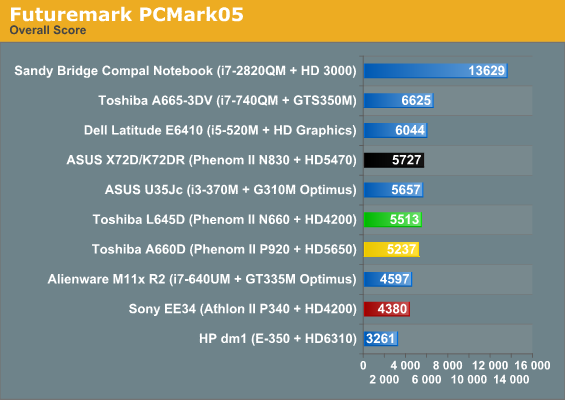
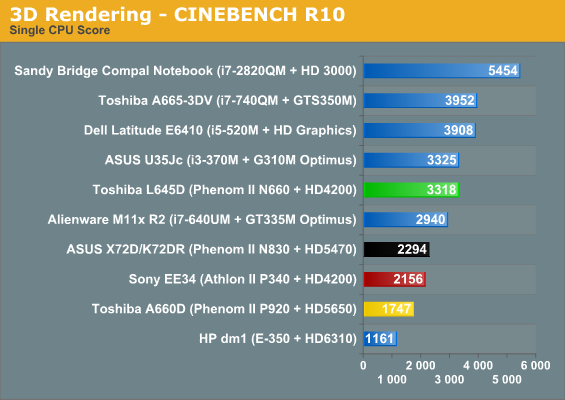
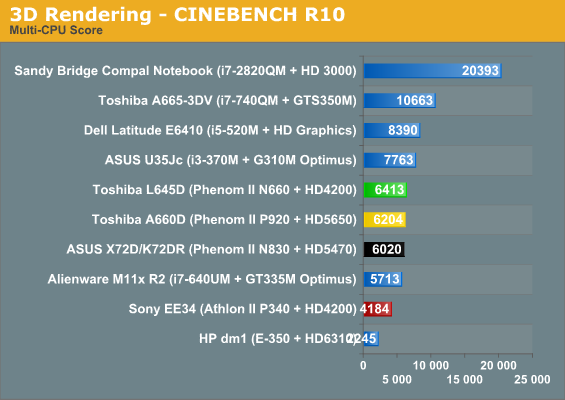

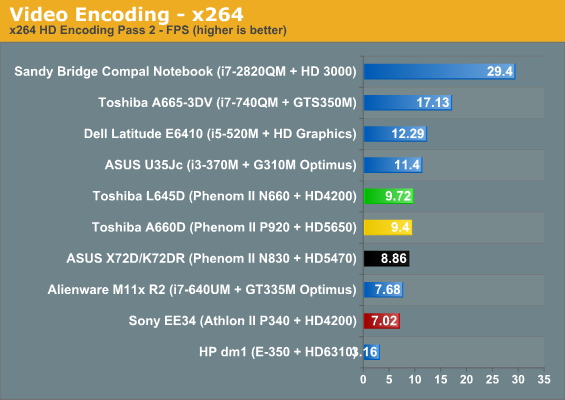
The two main take-aways here are that at 3GHz, AMD can at least hang with the i3-370M for the most part, and that AMD's mobile tri-core and quad-core chips were probably ill-advised. The extra headroom afforded by only having two cores allows the N660's 3GHz core clock to meet or beat the P920 with its four 1.6GHz cores and the N830 with its three 2.1GHz cores in even heavily threaded workloads. Ultimately the N660 is going to seem a little slow by comparison, but it's still offering a healthy amount of performance for most tasks and I wouldn't be completely aggravated doing more processor-intensive work (like video editing) on it.
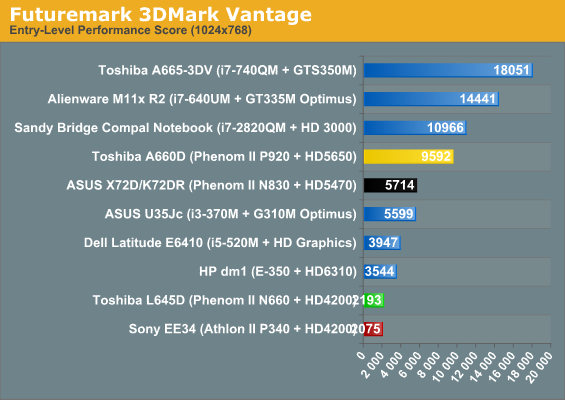
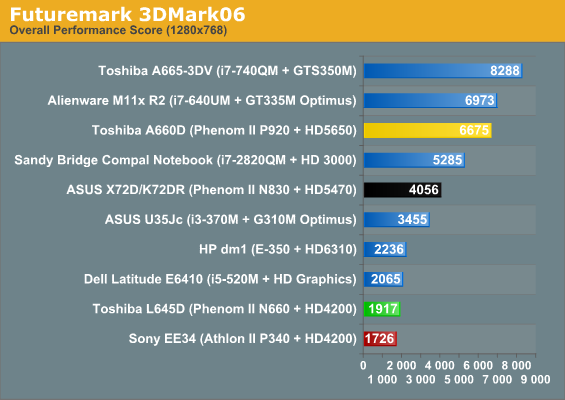
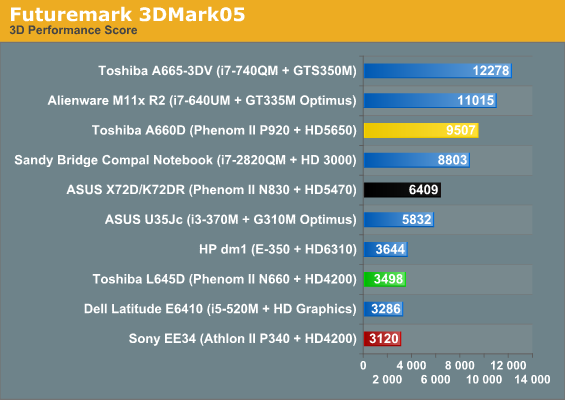
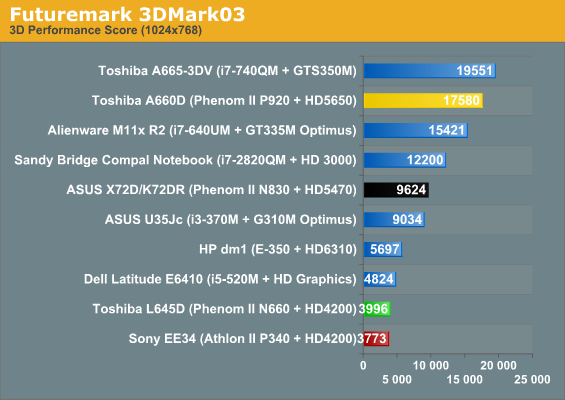
Unfortunately, though the extra 800MHz on the processor gives the L645D a leg up on Sony's EE34, the HD 4200/4250 starts to show its age again. Intel's HD graphics in the Dell Latitude post numbers on par with it in most disciplines (beating it soundly in 3DMark Vantage), but when we get to actual game testing we'll find that to be less the case.
This is where it would be good to point out that Toshiba loses one of the main points of leverage AMD's integrated graphics have over Intel's solutions: driver quality. As Jarred has mentioned in the past (and it does bear repeating), Toshiba has inexplicably opted out of AMD's mobile driver program, leaving you at their mercy. Sony doesn't get off any lighter: they opted out, too. There's really no good reason for this (especially since downloading the actual driver on another machine and then installing it on these notebooks still works), and it actively sabotages one of the strongest aspects of AMD's graphics hardware.
Still Not Enough to Game
At this point you should be expecting these results: the HD 4200/4250 just isn't powerful enough to run modern games at 768p. That said, reviewing the L645D gives us an opportunity to at least gauge how much CPU power can affect gaming performance with the HD 4200/4250 as well as pad out our results for two recent bench inductees: Mafia II and Metro 2033.

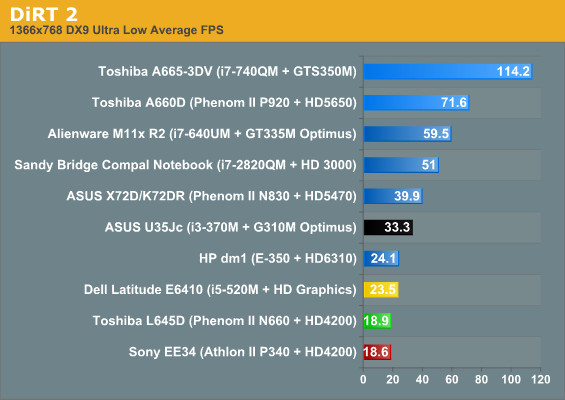
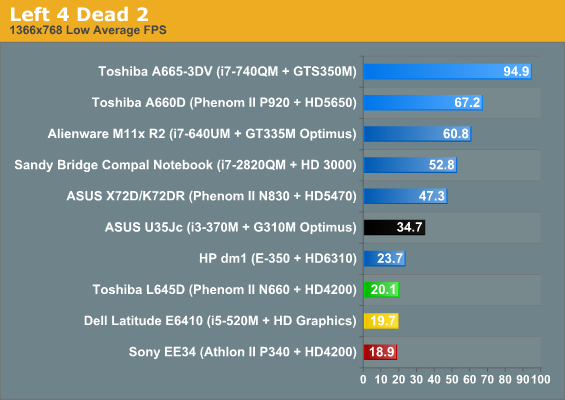
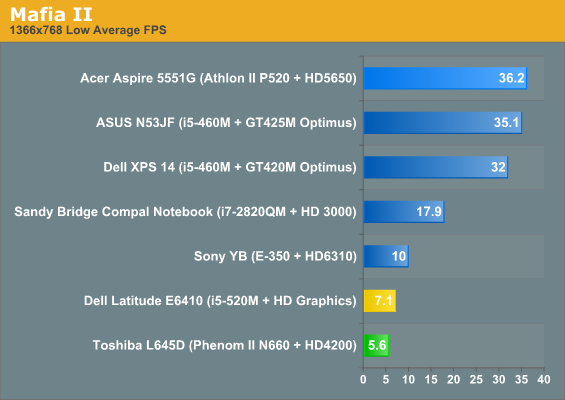
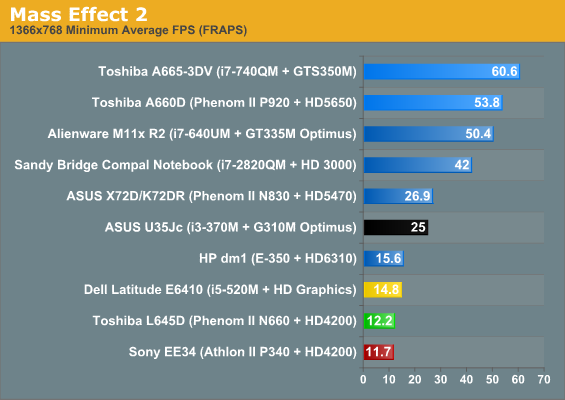
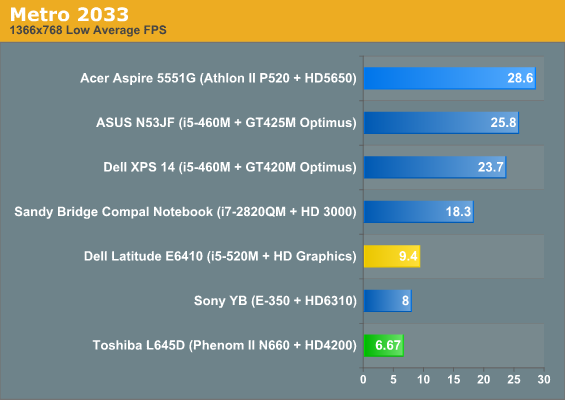
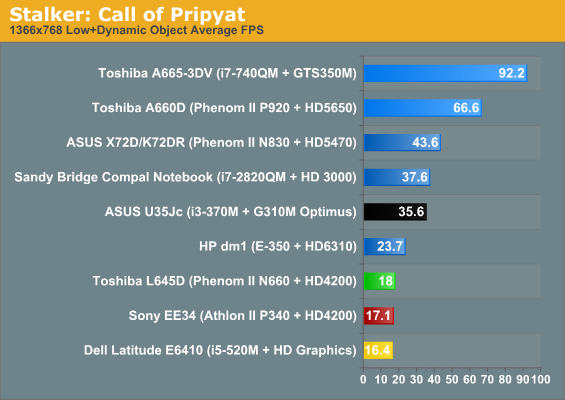
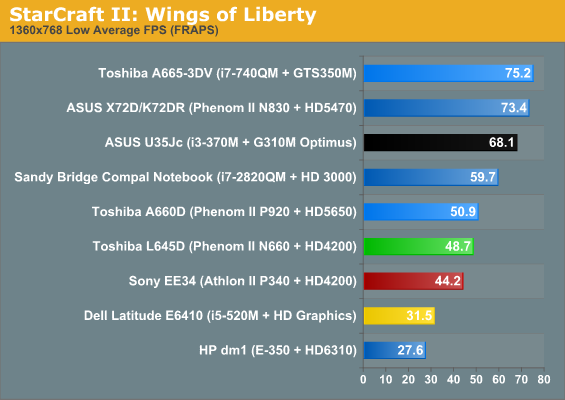
At 768p the GPU is too heavily taxed for any improvement in CPU performance to pick up slack; the only game that shows any improvement is the notoriously CPU-limited StarCraft II; everything else performs basically on par. Notice how NVIDIA's dismal GeForce 310M, the subject of endless ire among AnandTech staff, still offers a substantial improvement. I've said it before and I'll say it again (many times no doubt): Llano can't get here soon enough.
These are all recent titles, of course, and if you go back several years you can certainly find older games that will run fine on HD 4250. Jarred is working on a roundup of sorts to pit AMD's Brazos, HD 4225, and HD 4250 against Intel's GMA 4500MHD, HD Graphics, and HD Graphics 3000 with a suite of older/less demanding games. Generally speaking, you'll need low to medium detail with titles from around 2006, or if you want high details you'll need to go back to circa 2003. Stay tuned for that article....
Mostly Portable
A point where AMD-based notebooks have traditionally suffered (with the notable exceptions of both Sony's EE34 and pretty much anything Fusion-based) is battery running time. Toshiba equips the L645D with a mediocre six-cell, 48Wh battery that may somewhat dampen the mobility of a notebook that's otherwise fairly portable.
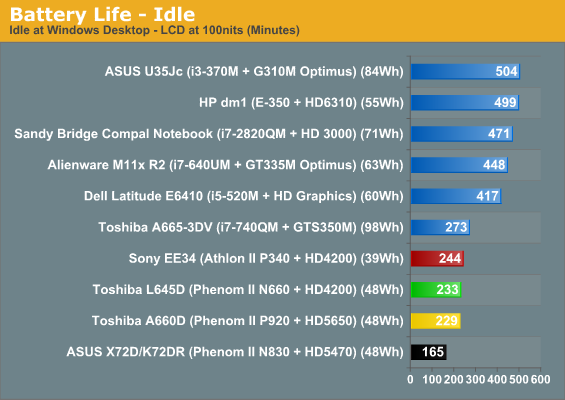
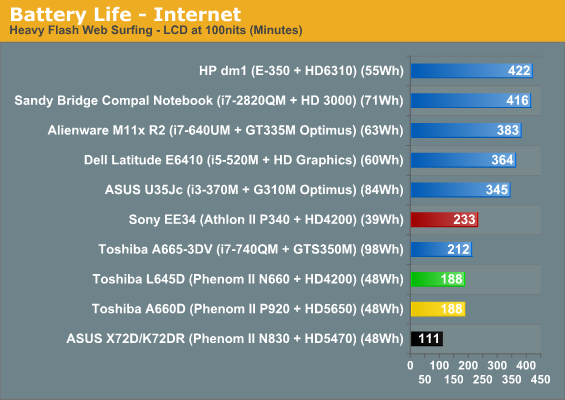
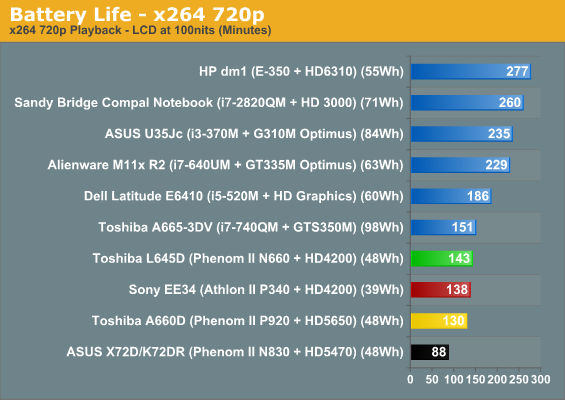
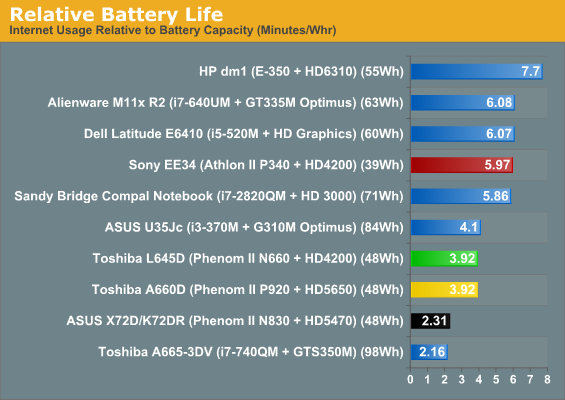
The relative battery life of the L645D isn't completely dire, but the Sony EE34's 25-watt processor runs roughshod over it. In practice, though, the L645D is still able to achieve three hours of useful running time surfing the internet. This is something Jarred's mentioned before and we've discussed at length: if you look at the running times of the Intel-based notebooks, you'll notice they're all equipped with much larger batteries. It seems like manufacturers almost deliberately cripple AMD-based notebooks.
We're not suggesting the L645D would offer battery life on par with an equivalent Intel machine, but it's still hamstrung by a middling battery. It's also clear there are power optimizations left on the table, as the Sony EE34 posts better battery life in two of the three tests despite having a smaller battery; the H.264 playback test is closer to what we'd expect, but the Internet test in particular has Sony leading by over 50% in relative battery life.
Heat and Noise
Given the smaller chassis of the L645D compared to some of the larger notebooks we've reviewed, it isn't unreasonable to expect it's going to have a tougher time dealing with the thermals of the Phenom II N660. We were pleasantly surprised.
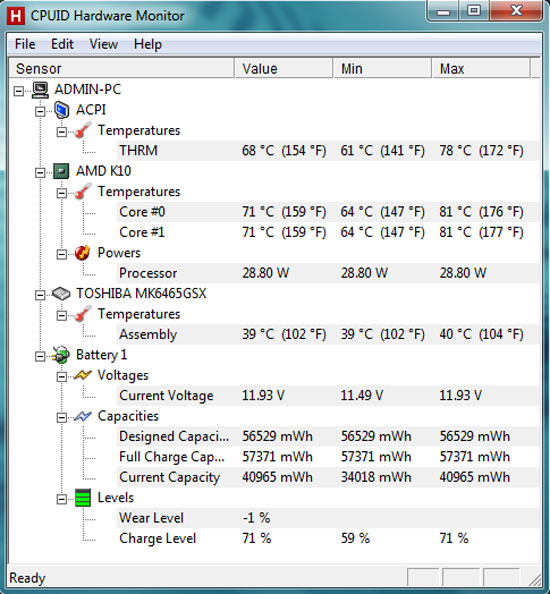
The processor temperatures are going to seem a little alarming, but they're not too far from where we've seen Arrandale-based notebooks hit. It may be better to look at the hard drive's temperature, which remains constant under both idle and load: 40C is perfectly reasonable. The L645D isn't in danger of overheating.
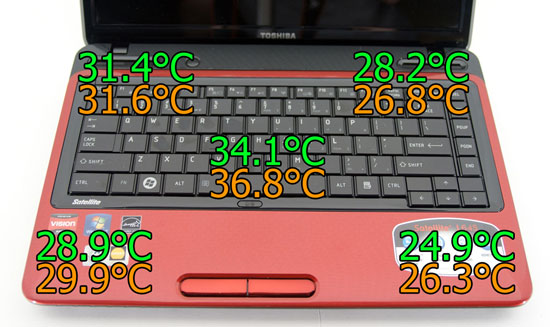
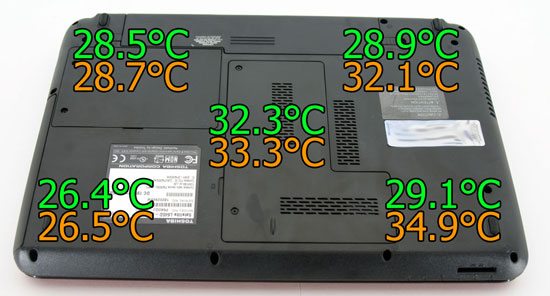
Idle and load surface temperatures are a little hotter than some of the other notebooks we've reviewed recently, but still nothing to complain about. Palmrests remain comfortably cool, as does the bottom of the notebook, with the center of the keyboard getting the hottest under sustained load. The central hot spot's 36.8C equates to roughly 100F, which is by no means cool but also not swelteringly hot either.
The L645D actually handles heat pretty well, and though the fan can definitely spin up noticeably under load, it's not aggravatingly loud and certainly not any louder than competing notebooks tend to be.
At Least 720p Makes Sense Here
More and more on 15.6" notebooks, the 720p resolution feels almost idiotically low. The LCD industry must be thankful Windows XP isn't in heavy rotation anymore: between the look of Luna and the gigantic taskbar on a 15.6", 720p screen, every notebook would feel like it was shipped from Fisher Price's laptop division. At least on the L645D's 14" screen, 720p makes more sense. Keep in mind that this notebook retails for $619 when you look at our test results, though. You get what you pay for; asking for DreamColor at that price is dreaming at best—foolhardy at worst.

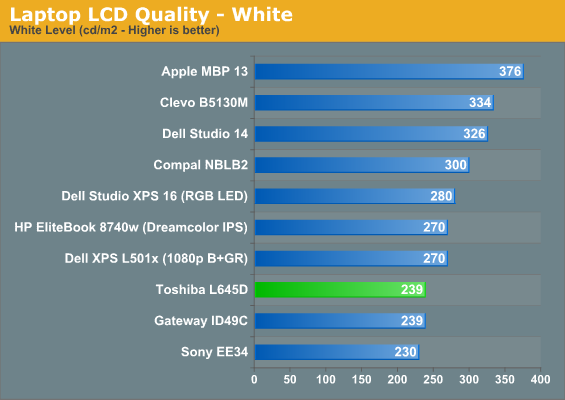

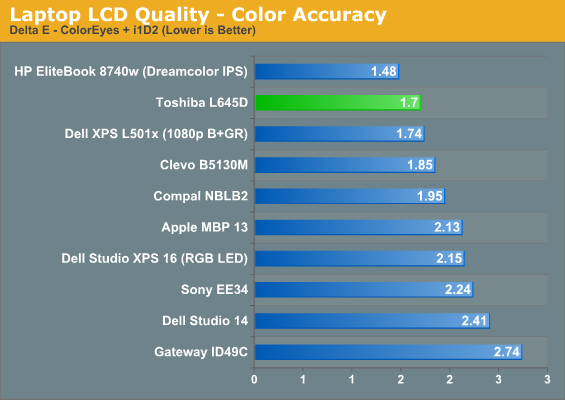


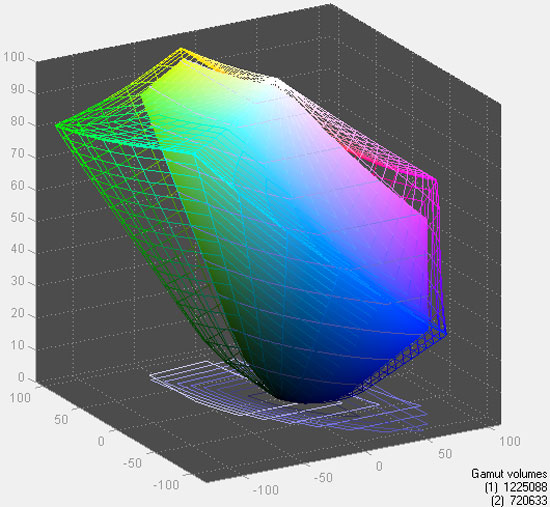
The L645D's display isn't great but it's not completely awful either, offering decent brightness and color gamut. What is troubling is a trend I'm noticing on more and more of these budget systems: the screen lattice and poor dithering on these cheap 720p TN panels seems to be getting more and more apparent, and it's a problem not easily captured in photos. It was most egregious on Gateway's ID49C (still our champion worst notebook screen), but has been present on both this notebook and the Sony EE34.
Viewing angles aren't great either, with massive washout at low angles and some trouble finding the "sweet spot." That problem has historically been extremely common in 14" notebooks, though, to the point where you might as well ask for a GeForce GTX 485M for how often you find a large sweet spot in this form factor.
Conclusion: But it's $619
Reviewing the Toshiba L645D-S4106 has left me with decidedly mixed feelings. Cheap Arrandale-based notebooks are going to provide better processor performance than even AMD's fastest in the L645D, and they'll offer better battery life in the process. Likewise, I really wish Toshiba would just put glossy plastic out to pasture. I've griped about this before but it bears repeating: glossy plastic photographs reasonably well and that's about it, and using it on the keyboard is a horrendous idea.
But...the L645D is $619.
Taken in a vacuum the L645D might be underwhelming, but thankfully for Toshiba (and possibly you and Joe Sixpack), it's not in a vacuum. Toshiba attacks the budget market fairly aggressively, and the value proposition of this notebook is certainly strong. The processor may be competing with some of Arrandale's slowest, but Arrandale's architecture is really quite fast so there isn't much to complain about there. Toshiba may be shipping it with a slow hard drive, but that drive still packs 640GB of capacity. The Mobility Radeon HD 4250 may be on its last legs, but it still gets the job done in a pinch (and at very low settings). And hey, you get a Blu-ray drive standard and an HDMI output to use it with.
A quick visit to NewEgg proves that if you want the 14" form factor, you're going to have to spend a little more to get it. There aren't any cheaper 14" notebooks with the Blu-ray drive, and there are maybe one or two available that promise better CPU performance than the L645D does. If you're buying on a budget you need to accept that you'll have to make some trade-offs. In the case of the L645D, that means putting up with Toshiba's glossy finish (really only an authentic nuisance on the keyboard) and middling battery life in exchange for a decent processor, a Blu-ray drive, and mobility. For the college student strapped for cash the L645D may not be such a bad call, but because it's a budget notebook you're really going to have to decide what's important to you.
Under the circumstances we'd suggest taking the L645D (or a similarly built Toshiba notebook) for a test drive in retail before taking the plunge. The entire L640 line looks like it offers tremendous bang for the buck, with this one being king of the castle. It's tough to recommend any budget notebook because of all the trade-offs that are always involved, but if you need something portable and don't have a lot to spend the L645D is a good option. If you're in the above situation, though, losing Blu-ray and saving another $100 is probably an even better idea.
0 comments:
Post a Comment